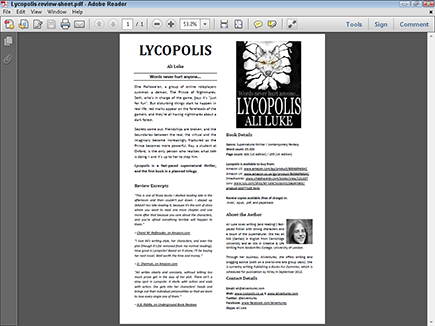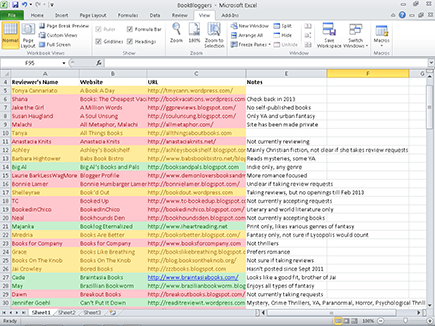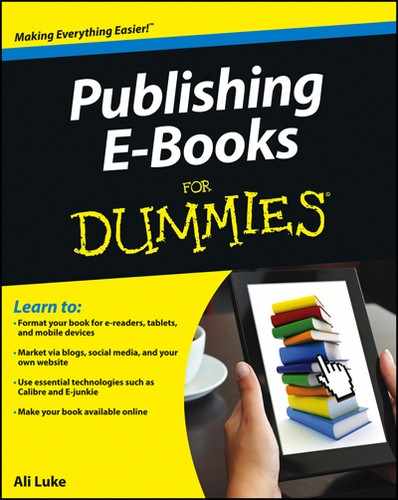Figure 18-2: The PDF information sheet for Lycopolis.
Approaching Book Bloggers for a Review of Your E-Book
Your own blog might not have many readers yet — and even if you have a large readership, you’ll still want to reach out beyond your blog to other audiences. One of the best ways to do this is by getting your e-book featured on book-related sites. This technique is particularly useful for fiction, where many individuals run review sites. (The later section “Writing Guest Posts for Relevant Blogs” guides you through a similar process for a nonfiction e-book.)
The book-blogging world is full of dedicated readers who love writing about the books they’ve been enjoying. Many of these people are enthusiastic about indie authors — people who have published books on their own, without the backing of a major publishing house. Some book bloggers have small, quirky websites that they run in their spare time, and others have created a major online presence, often with teams of reviewers.
Creating an e-book information sheet
Many book bloggers, especially established ones with larger audiences, receive far more review requests than they can handle. To boost the possibility of your e-book being accepted for review, show that you’re serious and professional about your writing — and make the fulfillment of your request as easy as possible.
One effective way to do this is by creating an information sheet for your e-book: This one- or two-page PDF document captures crucial information about you and the book so that reviewers have it all in hand. In Figure 18-2, you can see an example, in my own information sheet for my novel, Lycopolis.
Include these items on your information sheet:
![]() A blurb (a short description of your e-book): You generally don’t need to give a whole synopsis. The blurb you wrote for Amazon or other stores works fine.
A blurb (a short description of your e-book): You generally don’t need to give a whole synopsis. The blurb you wrote for Amazon or other stores works fine.
![]() The cover image: It makes sense to put this image alongside or above the blurb. Be sure that you have several versions of your cover image, in different sizes, saved on your computer. Then you can easily send them out to book bloggers when your review requests are accepted.
The cover image: It makes sense to put this image alongside or above the blurb. Be sure that you have several versions of your cover image, in different sizes, saved on your computer. Then you can easily send them out to book bloggers when your review requests are accepted.
![]() Excerpts from reviews about your e-book: Ideally, you’ll have at least a couple of reviews on Amazon before approaching book bloggers to request a review on their sites. (Yes, it sounds like a Catch-22 — your first reviews might come from writer friends who’ve helped you with the editing phase of your e-book.)
Excerpts from reviews about your e-book: Ideally, you’ll have at least a couple of reviews on Amazon before approaching book bloggers to request a review on their sites. (Yes, it sounds like a Catch-22 — your first reviews might come from writer friends who’ve helped you with the editing phase of your e-book.)

![]() Information about you, including relevant qualifications or experience: If you’ve published other e-books, or if you’ve written for magazines or large blogs, you may want to mention them here, to help reassure book bloggers that your writing is of high quality.
Information about you, including relevant qualifications or experience: If you’ve published other e-books, or if you’ve written for magazines or large blogs, you may want to mention them here, to help reassure book bloggers that your writing is of high quality.
![]() A photograph of you: A photo isn’t essential, but it helps create visual interest and a personal connection.
A photograph of you: A photo isn’t essential, but it helps create visual interest and a personal connection.
![]() Details of where your e-book is available online: A book blogger who writes a review will almost certainly want to link to your e-book at Amazon and, potentially, in other stores.
Details of where your e-book is available online: A book blogger who writes a review will almost certainly want to link to your e-book at Amazon and, potentially, in other stores.
![]() A note on formats available for review: Book bloggers will want to know whether you provide their favorite formats.
A note on formats available for review: Book bloggers will want to know whether you provide their favorite formats.
 Offer as many of the major formats as possible to reviewers, including EPUB, MOBI, and PDF.
Offer as many of the major formats as possible to reviewers, including EPUB, MOBI, and PDF.
Finding book bloggers who cover your genre or niche
Some book bloggers cover a wide range of material, including almost any genre of fiction, plus some nonfiction. Many, though, specialize in certain genres, and others have lists of genres that they never review.
Don’t waste your time — and a book blogger’s time — by sending out review requests to someone who doesn’t deal with your type of book. Do some research yourself, and create a list of book bloggers who will be a good fit for you.
In Figure 18-3, you can see how I researched this topic: I created a spreadsheet for myself, based on an existing list of book bloggers. (Thanks to Rachel Abbott and Greg Scowen.) You can see the list at http://rachelabbottwriter.wordpress.com/2012/03/13/reviews-the-good-the-bad-and-the-scams
. I looked at every blog, read their review guidelines, determined the sorts of books they dealt with, and marked up the spreadsheet accordingly by color-coding the lines with these colors:
![]() Red: These blogs no longer existed, were closed to submissions, didn’t accept e-books, declined books from independent authors, or definitely didn’t deal with my genre.
Red: These blogs no longer existed, were closed to submissions, didn’t accept e-books, declined books from independent authors, or definitely didn’t deal with my genre.
![]() Yellow: These blogs accepted books in my genre but didn’t specialize in it.
Yellow: These blogs accepted books in my genre but didn’t specialize in it.
![]() Green: These blogs specialized in my genre or were good targets in other ways, such as having large readerships.
Green: These blogs specialized in my genre or were good targets in other ways, such as having large readerships.
You’re free to come up with a different system. For example, you can choose a color for blogs that would be a good fit but are closed for submissions. That way, you can return to them several months later.
If you find a blog that seems to be a good fit (I’ve labeled some in green on the spreadsheet shown in Figure 18-3), check out the sites that they link to in their sidebars, often in the Blogroll section.
Figure 18-3: Spread- sheet of book bloggers.

